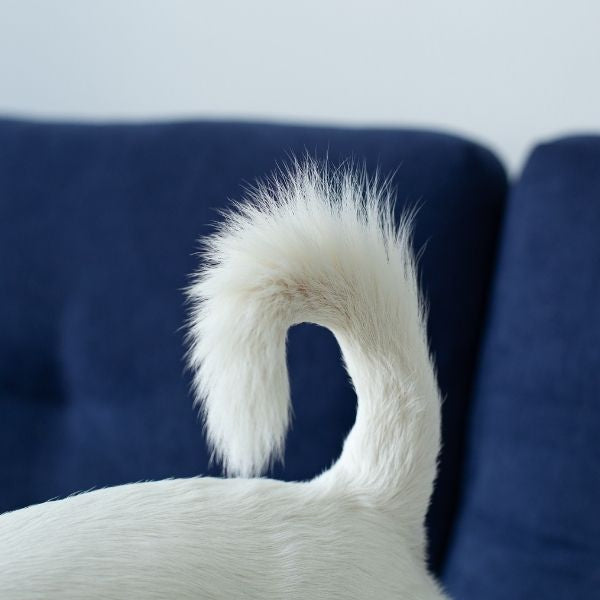How much notice do you take of your dogs tail? Other than grabbing your drink before it gets swept off the coffee table, you might not have given it much thought. I know when I got my first dog, I didn't give it much thought at all.
Did you know that unlike humans, dogs don't have a set number of bones in ther body? The average number is 319, but the actual number can be a few either side of this, and that's all because of their tail. The longer the tail, the more bones the dog has!
And if you look closely you'll see that different breeds have very different tails.
Tails can be long or short, straight or curved, smooth or feathery.
Dog Tail Positions
Some breeds such as beagles and terriers have a high set tail where the tails just appears to be a natural extension of the spine. These dogs tend to carry their tails high when they are in a pack - beagles have been bred to have a white tip to their tails so that they are readily visible when out hunting.
Other breeds or groups such as sighthounds have tails which are lower set. Sighthounds eg greyhoungs, salukis are very fast dogs - having a lower set tails is thought to help them with their balance at the high speeds they travel at.
Some breeds such as akita, husky, malamute have tails which naturally curl up and over the back. These breeds originated in cold Northern countries, and they use their tail for warmth when curled up - it keeps the nose and face warm.
Dogs which are happy in the water eg retrievers have a tail which is quite short in proportion to their body, thick and furry. The shape helps them use their tail as an effective rudder when swimming.
What about a carrot tail? Short and thick at the base, these are usually found on smaller dogs such as jack russels and westies who were bred as vermin hunters - easy to grab hold of the tail when the dog has it's head stuck down a hole!
The shapes and sizes of tails are specific to the attributes and characteristics of the breed, and are one of the features which breeders are interested in when looking to improve the lines of their breed. THey also give us clue as to the origins of a breed, even if we aren't going to hunt with our dogs, it's useful to know that this is part of their histroy.
What Do Dogs Use Their Tail For?
The tail principally has two uses as far as the dog is concerned.
Firstly, it's a balance aid. Dogs use their tails to stay balanced when running, jumping and changing direction. If you ever get the opportunity to watch dogs competing in agility, take a look at their tails.
This is a video of Baldrick when he had just started competing - we weren't very quick so it's not a great example, but it's fun to watch!!
Dogs who swim use their tail like a rudder - as mentioned above, dogs who were bred to swim have tails "designed" to be used this way.
The other thing that dogs use their tails for is communication.
Dogs Talk With Their Tails
Now, if you have an anxious dog, you won't be surprised to hear how irritated I am by owners who say "it's ok, he's friendly" when their dog has a tail that is flicking backwards and forwards slowly.
Dogs use their tails to communicate. Some things are pretty obvious - when the tail is wagging the dog, it's fair to say the dog is happy.
What about if the dog is wagging it's tail slowly, from side to side in a horizontal manner? This dog is not happy, they are anxious. If in response to another dog, this could be a precursor to a fight.
When the tail is tucked between the legs, most people believe that this means the dog is submissive, but it is also an indication of fear - so context is important to know what your dog is saying.
What about when the dog has an erect tail? It could mean the dog is confident, but it could also mean that the dog is alert to something - the rest of the body tells the rest of the story. If the tail is erect and also wagging quickly, maybe the dog has spotted something and is about to run off at high speed to catch it's prey.
Pet Profession Guild have an excellent resource about tail wagging here
This infographic from Dog Health is useful for a visual guide.

Share your thoughts on tails - does your dog have a quirky habit? Wag so hard that his whole body moves - yes Marvinnotabeagle, I'm looking at you lol.




